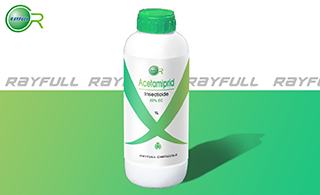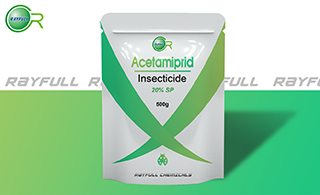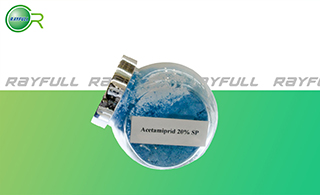Acetamiprid
    啶虫脒 啶虫脒
Introduction: Acetamiprid is an odorless, neonicotinoid insecticide composed from a synthetic organic compound. Neonicotinoid insecticides target the nervous system of insects causing paralyzation. Acetamiprid is generally used to protect plants against sucking insects such as aphids, but it has also become common in household pest control to combat bed bugs. It is a broad-spectrum pesticide that can be used on plants ranging from leafy vegetables and fruit trees to ornamental plants.
Common name: Acetamiprid
Another name: Mospilan; Intruder; Stonkat; Assail; Piorun; Prize; etc.
Chemical name:
(E)-N1-[(6-chloro-3-pyridyl)methyl]-N2-cyano-N1-methylacetamidine
Empirical formula: C10H11ClN4
Structural formula:

Mol. Weight: 222.67 g/mol
CAS No.: 135410-20-7
Specifications
Leading Acetamiprid supplier
Acetamiprid 95% TC
Acetamiprid 97% TC
Acetamiprid 20% SP
Acetamiprid 20% EC
Packing:
BULK PACKING
Powder: 25kg/Bag, 25kg/Drum, 50kg/Drum etc.
Liquid: 200L/Drum, 20L/Drum, 10L/Drum etc.
SMALL PACKING
Powder: 1kg/Alu bag, 500g/Alu bag, 200g/Alu bag, 100g/Alu bag, 50g/Alu bag, 15g/Alu bag etc.
Liquid: 5L/Drum, 1L/Bottle, 500ml/Bottle, 250ml/Bottle, 100ml/Bottle, 50ml/Bottle etc.
Customerized packing label
Acetamiprid FAO standard
Professional registration
HAZARDS IDENTIFICATION
Hazard statement(s)
H301: Toxic if swallowed.
H302: Harmful if swallowed.
H330: Fatal if inhaled.
H412: Harmful to aquatic life with long lasting effects.
Precautionary statement(s)
P260: Do not breathe dust/fume/gas/mist/vapors/spray.
P264: Wash ... thoroughly after handling.
P270: Do not eat, drink or smoke when using this product.
P284: [In case of inadequate ventilation] Wear respiratory protection.
P301+P312: IF SWALLOWED: call a POISON CENTER/doctor/... IF you feel unwell.
P304+P340: IF INHALED: Remove victim to fresh air and keep at rest in a position comfortable for breathing.
P310: Immediately call a POISON CENTER or doctor/physician.
P320: Specific treatment is urgent (see ... on this label).
P330: Rinse mouth.
P405: Store locked up.
P501: Dispose of contents/container to.
Supplemental Hazard Statements: none.
MAMMALIAN TOXICOLOGY
Acute toxicity: 1) Acute oral LD50 for rats is 146 mg/kg. 2) Acute dermal LD50 for rats is >2000 mg/kg. 3) Acute inhalation toxicity LC50 (4 h) for rats is >1.15 mg/l. 4) Skin irritation: Non-irritating to skin (rabbits). 5) Eye irritation: Non-irritating to eyes (rabbits). 6) Skin sensitization for guinea pig: Not a skin sensitiser.
NOEL: NOEL (2 y) for rats is 7.1 mg/kg bw per day, (18 m) for mice is 20.3 mg/kg bw per day, (1 y) for dogs is 32 mg/kg bw per day. Other No evidence of carcinogenicity from animal studies. Not genotoxic in laboratory studies. Not teratogenic in animal studies.
ADI (JMPR) 0-0.07 mg/kg b.w.[2011]
Classification:
WHO Classification: II (Moderately hazardous)
EC Risk Classification: Xn - Harmful: R22; N - Dangerous for the environment: R52/53.
US EPA Classification (formulation): No consensus across products or no products available.
ECOTOXICOLOGY
Effect on birds: Acute oral LD50 for Mallard is 98 mg/kg. Effect on fish: Acute LC50 (96 h) for Rainbow trout is >100 mg/l. Effects on aquatic invertebrates: Acute EC50 (48 h) for Daphnia magna is 49.8 mg/l. Effects on algae: Acute EC50 (72 h) for Scenedemus subspicatus is >98.3 mg/l. Effects on bees: Contact acute (48 h) LD50 is 8.09 μg/bee, Oral acute (48 h) LD50 is 14.53 μg/bee. Effects on earthworms: Acute 14 day LC50 is 9 mg/kg.
ENVIRONMENTAL FATE
If released to air, an estimated vapor pressure of 4.4×10-5 mm Hg at 25℃ indicates acetamiprid will exist in both the vapor and particulate phases in the ambient atmosphere. Vapor-phase acetamiprid will be degraded in the atmosphere by reaction with photochemically-produced hydroxyl radicals; the half-life for this reaction in air is estimated to be 5 hours. Particulate-phase acetamiprid will be removed from the atmosphere by wet and dry deposition. Acetamiprid may undergo direct photolysis in the atmosphere based on a reported aqueous photolysis half-life of 34 days. If released to soil, acetamiprid is expected to have moderate to high mobility based upon Koc values ranging from 132-267. Volatilization from moist soil surfaces is not expected to be an important fate process based upon an estimated Henry's Law constant of 6.9×10-8 atm-cu m/mole. Acetamiprid is not expected to volatilize from dry soil surfaces based upon its vapor pressure. Half-lives of acetamiprid in various US and European soils reported from aerobic soil metabolism studies range from <1 day to 8.2 days. If released into water, acetamiprid is not expected to adsorb to suspended solids and sediment based upon the Koc values. Based on aerobic soil metabolism half-lives ranging from <1 day to 8.2 days, acetamiprid is expected to biodegrade in water. Volatilization from water surfaces is not expected to be an important fate process based upon this compound's estimated Henry's Law constant. An estimated BCF of 2 suggests the potential for bioconcentration in aquatic organisms is low.
Usage: Acetamiprid was developed by Aventis CropSciences. It is systemic and intended to control sucking insects on crops such as leafy vegetables, citrus fruits, pome fruits, grapes, cotton, cole crops, and ornamental plants. It is also a key pesticide in commercial cherry farming due to its effectiveness against the larvae of the cherry fruit fly.
Application: Biochemistry Agonist of the nicotinic acetylcholine receptor, affecting the synapses in the insect central nervous system. Mode of action Systemic insecticide with translaminar activity and with contact and stomach action. Uses Control of Hemiptera, especially aphids, Thysanoptera and Lepidoptera, by soil and foliar application, on a wide range of crops, especially vegetables, fruit and tea. Applied at 75-300 g/ha on vegetables, 100-700 g/ha in orchards.
| 






